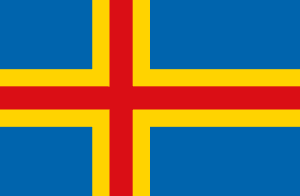
| Colors | HEX Code | RGB | CMYK |
|---|---|---|---|
| Blue | #0064AD | 0, 100, 173 | 100, 42, 0, 32 |
| Yellow | #FFD300 | 255, 211, 0 | 0, 17, 100, 0 |
| Red | #DA0E15 | 218, 14, 21 | 0, 94, 90, 15 |
The Aland Islands are a Finnish Autonomous region. It Is connected to land by one land border that is common with Sweden. Therefore, its flag has a blue base, adorned with a yellow Nordic cross. In order to distinguish it from the Swedish flag, and represent the Finnish identity of the islands, there is a red cross inside the yellow one.
The Åland Islands Flag Meaning
The blue color in the Åland Islands flag represents the position of the Archipelago in the sea. The yellow cross stands for the island’s history which was part of the Swedish kingdom. The red cross represents Finland, to which the Archipelago belongs now.
History of the flag
The Åland Islands flag was an unofficial striped one with two colors, blue and yellow. However, this flag was banned by the Finnish government in 1935. The Åland Islands sought independence after Finland was free from Russian occupation in 1917, fearing that they would lose their Swedish identity. Their appeal for autonomy was supported by Sweden, Finland, and Russia. Then, a competition was held to choose the right flag after Finland granted autonomy to the Åland Islands at the beginning of the 1950s.
The flag was hoisted for the first time in Mariehamn, the capital of the Åland Islands, on April 3, 1954. It was officially adopted on May 15, 1954, stressing the Nordic heritage of the islands, the Swedish cultural identity, and the Finnish rule.